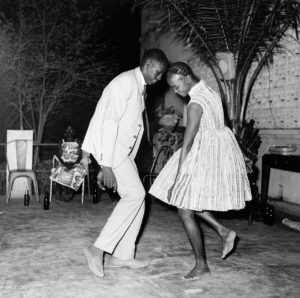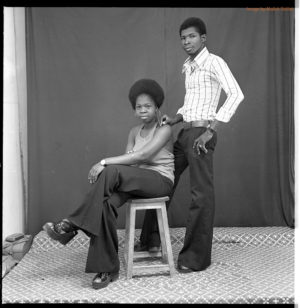
Malick Sidibé, Nuit de Noël (Happy Couple), 1963, gelatin silver print, 44.5 x 44.8 cm (Solomon R. Guggenheim Museum) © Malick Sidibé
Recently, I received a wedding invitation that asked guests the question: “What song will bring you to the dance floor?” The songs I chose (I couldn’t pick just one!) reflected a few considerations: songs I enjoy personally and would dance to in front of others, songs that most guests might be familiar with, and songs that express the celebratory nature of the event.
When I look at Malick Sidibé’s black-and-white photograph of a young man and woman dancing in Bamako, the capital city of Mali, I wonder which song brought them to the dance floor. The picture portrays a candid, private moment. Clearly the focus of the photograph, the figures, who are siblings, fill up the space of the square composition. The flash from the camera flattens and exposes the intimate dance that they share, and reveals the expression of joy and pleasure on their faces. Furthermore, their illumination in the foreground contrasts sharply with the darkness of the night sky in the background.
The young man is outfitted with a suit, tie, and loafers, while the young woman dons a sleeveless dress with a full skirt and is barefoot. According to art historian Candace M. Keller, the brother is showing his younger sister how to dance. Facing each other, their heads are turned down, perhaps to look at one another’s feet and ensure that their movements are in sync. Their arms hang down, mirroring one another, with one foot raised up and the other on the floor. In the background, two trees frame the dancers, and their branches echo the curve of their bodies toward one another. We also see some bottles on the floor, and chairs, either occupied by guests or empty. The title of the photograph, Nuit de Noël (Happy Couple), supplies us with additional details: that it is Christmas Eve or Christmas night, and that the siblings are happy. [1]
Fun and festive, the photograph is exemplary of Sidibé’s best known body of work: photographs of young people at social gatherings and events during the 1960s and 1970s. A young man himself at the time, Sidibé was hired to take photographs of young men and women dancing at parties and clubs, and engaged in leisure activities, such as picnicking along the Niger River. These young people (only the young men, according to Sidibé) purchased the photographs as souvenirs.
Furthermore, these photographs of young people reflect how they created identities for themselves that did not comply with the cultural norms of their parents’ generation. In the 1960s, youth in Bamako were heavily influenced by the introduction of Afro-Cuban music, rock n’ roll, and rhythm and blues, and the social liberties and fashions advocated by popular music stars, specifically the American musician, James Brown, and the British band, The Beatles. American and French films, particularly Western, spy, and detective movies, inspired fashions among young people as well. The brother and sister in Nuit de Noël (Happy Couple) demonstrate youth culture at the time through their choice to go out at night and through their manner of dress.
In particular, the way that the young woman is dressed might have presented a problem to the preceding generation. While she appears modestly dressed to today’s viewers, her parents’ generation might have regarded her outfit as inappropriate, as women were expected to wear pagne, or a wrap skirt. Emboldened by American and European stars, young women wore miniskirts and bell-bottoms even though they risked disapproval or punishment from conservative parents.
Nuit de Noël (Happy Couple) remains one of Sidibé’s most popular and most circulated photographs internationally. However, viewers often make assumptions and mistake the siblings in the picture to be a romantic couple, perhaps due to their proximity and the intimacy of the dance. Despite efforts to correct the persisting fiction that the couple is romantically linked, Candace M. Keller recalls from interviews with Sidibé that he found the misreading of this photograph and the people portrayed amusing. [2]
Impact of Malian independence
The carefree and exuberant attitude displayed by young people in Sidibé’s photographs coincides with the hopeful outlook held by many in the post-independence era (Mali had been a colony of France since 1892, and gained independence in 1960). Of the photographs taken at parties, Sidibé comments,
There was always music and a nice atmosphere, not a hint of sadness. Since I didn’t have to worry about fixing people’s hair and posing them properly, I was able to create spontaneous images of joy.[3]
Indeed, the siblings in Nuit de Noël (Happy Couple) reflect this joy, as they smile and are engrossed in their dance.

Malick Sidibé, A man and a woman dancing at a party outdoors, December 1972, black-and-white negative, 6×6 cm (Archive of Malian Photography, CC BY-NC-SA 4.0)
However, the joyfulness of young people in Sidibé’s photographs taken several years after independence masks economic hardship and social repression caused by the policies of Malian President Modibo Keïta (who was overthrown in a coup d’état in 1968, and from the decisions made by President Moussa Traoré during his dictatorship (1961–91). Due to governmental restrictions, young people in the late 1960s and 1970s became increasingly disillusioned. Fed up and frustrated, young people enjoyed their freedoms covertly and clandestinely. For instance, they hosted and went to secret parties at night in defiance of the government-imposed curfew.
Sidibé’s photographs of young people at parties during Keïta’s and Traoré’s presidencies resemble each other. For example, the demeanor of couples dancing (and aware of the camera) in photographs taken in the early 1960s, as well as in the late 1960s and the 1970s, appear similar. Besides these parties, young people continued to find the freedom to express themselves through their outfits and choices in props, backdrops, and poses in the space of the artist’s studio.
Studio Malick
While Sidibé enjoyed taking photographs of young people at parties and dances, he preferred taking black-and-white portraits of his clients in the studio, where he could participate more directly in the creative process. He initially worked for Photo Service, a studio and photo supply store owned and operated by the French photographer, Gérard Guillat-Guignard. Like Seydou Keïta, who belongs to the preceding generation of Malian photographers, Sidibé opened his own studio. His establishment, Studio Malick, was opened in 1962.

Malick Sidibé, A couple in profile, April 1975, black-and-white negative, 6×6 cm (photo: Archive of Malian Photography, CC BY-NC-SA 4.0)
Although the studio portraits that Sidibé took of his clients are not candid, some reflect the charm found in Sidibé’s photographs of young people in social settings, such as a 1975 portrait of a young couple in a three-quarter profile. Sitting on a stool with her legs crossed, the young woman wears a tank top, bell-bottom pants, platform shoes, a watch, a necklace, earrings, and ring. Behind her, a young man rests his right hand on her shoulder and poses his left hand against the pocket of his pants. He wears a plaid button-up shirt, pants, belt, watch, shoes, and ring. The couple is positioned against a solid-colored cloth backdrop, with a patterned cloth beneath them on the floor. Unlike the siblings in Nuit de Noël (Happy Couple), the couple in the portrait are inside in the studio space, posed, and looking directly at the camera. However, both couples appear intimate and don fashions popular with young people at the time.
Unlike his practice of going out to take photographs of young people, Sidibé’s studio practice endured well beyond the 1970s. The Archive of Malian Photography, which hosts photographs from the 1940s–90s taken by Malian photographers, contains a small portion of Sidibé’s extensive, prolific body of work. Looking through the archive, the viewer gets a sense of the clientele Sidibé worked with over the years. The brother and sister in Nuit de Noël (Happy Couple) are two of the countless clients that he photographed during his illustrious career.
Acknowledgments:
Many thanks to Dr. Candace M. Keller for her constructive feedback and insight for this essay.


